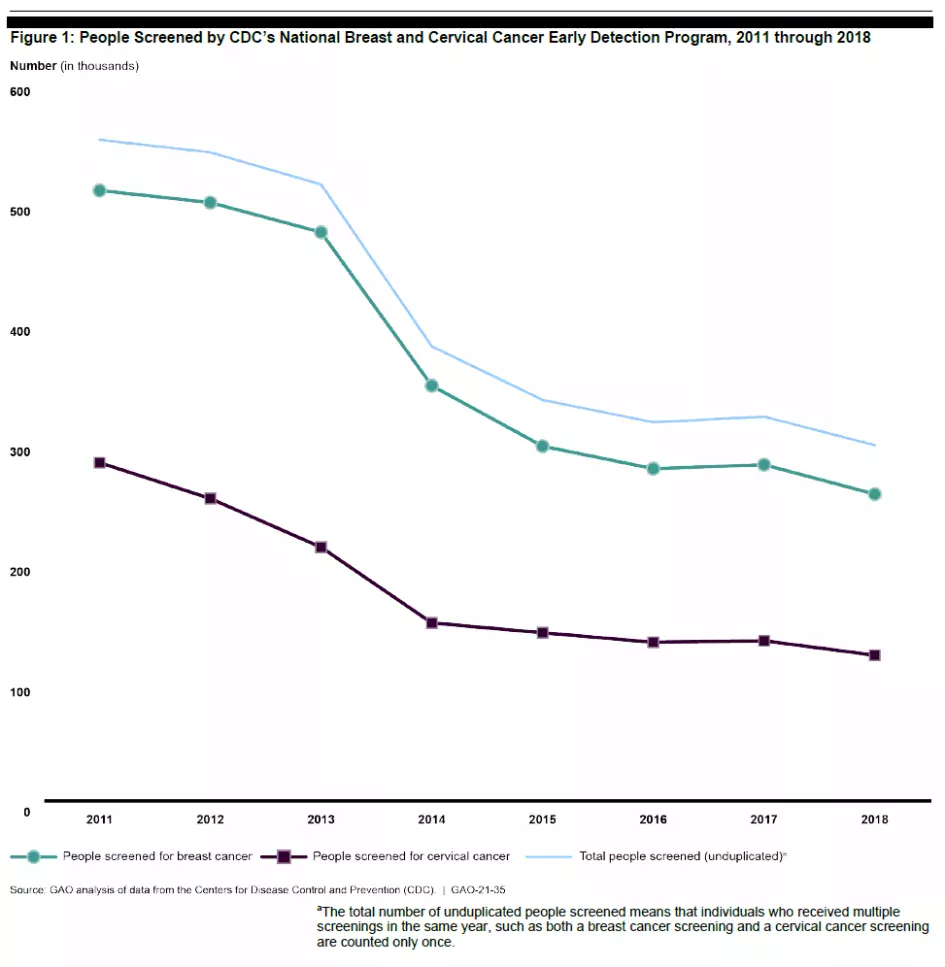Why is CDC Screening Fewer People for Breast and Cervical Cancer?
About 265,000 women in the U.S. were diagnosed with breast or cervical cancer in 2017, according to the most recently available data from the Centers for Disease Control and Prevention. Early screening and detection of cancer, followed by prompt treatment, can save lives. But what happens when people can’t afford such medical care?
For many people in need of breast or cervical cancer screening, the answer has been the CDC’s National Breast and Cervical Cancer Early Detection Program. It has provided cancer screening and diagnostic services to millions of low-income people without health insurance for nearly 30 years. However, the number of people receiving screenings through this program has declined dramatically in recent years.
Today’s WatchBlog explores our new report about this decline. Also, tune in to our podcast with GAO’s John Dicken—a health care policy expert and director in our Health Care team— to learn more.
Less uninsured people = Fewer screenings
In recent years, the number of people screened for breast or cervical cancer annually through the CDC’s Early Detection Program decreased by about 46%—from about 550,000 people in 2011 to just under 300,000 people in 2018.
What’s the cause for such a dramatic drop? CDC officials told us that health insurance coverage expansions under the Affordable Care Act, including Medicaid expansion beginning in 2014, were a major factor. Because the Early Detection Program serves people who lack health insurance coverage, a reduced uninsured population means less people are eligible. Sure enough, a CDC-funded study that estimated program eligibility showed decreases by 48% and 49% (for each type of cancer) between 2011 and 2017.
Figure: People Screened by CDC’s National Breast and Cervical Cancer Early Detection Program, 2011-18
Image

Why the Early Detection Program is still needed
While the Early Detection Program has seen a decrease in demand, there are still millions of people eligible for and in need of the services it offers. A recent study estimated that, as of 2017, about 2.8 million people were eligible for breast cancer screening and about 5.3 million were eligible for cervical cancer screening through the program.
Additionally, declines in demand for the program were not equally shared. Hispanic people and non-Medicaid expansion states have more need for the program than other groups. For example, while the number of Hispanic people screened for breast cancer each year decreased by just 3.3%, the number of non-Hispanic people screened decreased by 66.3%. By 2017, the percentage of Hispanic women eligible for the program was estimated to be about 2 times as high as the percentage of non-Hispanic Black women eligible and about 4 times as high as the percentage of non-Hispanic White women eligible.
How is the CDC responding to program changes?
In response to these trends, the CDC began making some changes to its program. In 2017, the program began focusing more on evidence-based strategies to help people overcome barriers that may prevent them from seeking screening in the first place—things like lack of trust in health care providers or language and cultural barriers.
The CDC also started collecting data related to these changes, but it is still too early to know the effects.
- Comments on GAO’s WatchBlog? Contact blog@gao.gov.
GAO Contacts
Related Products

GAO's mission is to provide Congress with fact-based, nonpartisan information that can help improve federal government performance and ensure accountability for the benefit of the American people. GAO launched its WatchBlog in January, 2014, as part of its continuing effort to reach its audiences—Congress and the American people—where they are currently looking for information.
The blog format allows GAO to provide a little more context about its work than it can offer on its other social media platforms. Posts will tie GAO work to current events and the news; show how GAO’s work is affecting agencies or legislation; highlight reports, testimonies, and issue areas where GAO does work; and provide information about GAO itself, among other things.
Please send any feedback on GAO's WatchBlog to blog@gao.gov.




